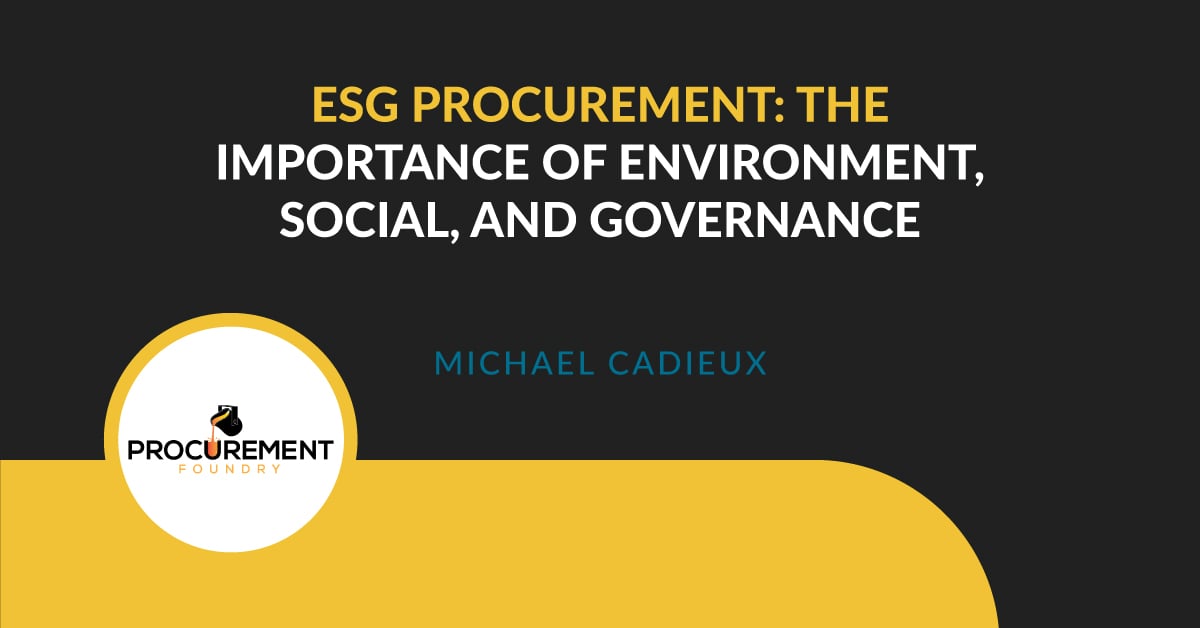Maximizing Savings Opportunities and Procurement's Strategic Value for CPOs
Saving money is not always about pinching pennies: advanced and data-driven insights enable you to identify real cost-saving opportunities, negotiate...
2 min read
![]() Michael Cadieux
:
6/19/22 8:00 AM
Michael Cadieux
:
6/19/22 8:00 AM

ESG procurement is high on the priority list for today’s procurement professionals looking for solutions to environmental supply chain issues. In this article, we’ll explain ESG and offer insights and advice on how to make your supply chain more environmentally friendly. And, let you know how you can learn more about ESG at our upcoming online FORGE event.
ESG—an acronym that stands for Environmental, Social, and Governance—refers to criteria we can use to evaluate companies’ impact on their environment (or their overall sustainability).
Much of the focus for ESG procurement is on how sustainable and environmentally friendly the supply chain is, including how the companies incorporate appropriate social representation (vendors and employees) and comply with government regulations from all points of contact in the procurement process, from A to Z.
Notably, since 2020, many global events have seismically shifted our worlds. Not only did COVID emerge, creating a global pandemic, but there have also been numerous social and political changes that have changed the dynamics. And don’t get us started on the extreme weather and climate change fears significantly impacting the globe.
Due to this, businesses and brands are becoming hyper-aware of why and how we do what we do. According to experts at SupplyChain247, “ESG practices combine elements of people, planet, and profitability while being governed by internal systems of practices, controls, and procedures. Although enterprises have traditionally had difficulty financially justifying ESG activities, the facts now present a very different picture.”
So, what does that picture look like today in ESG procurement?
Numbers don’t lie, and we are seeing a trend in consumer buying. Buyers are increasingly looking to bring their business to brands committed to offering sustainable products via sustainable practices.
According to an International Trade Centre (ITC) survey of retailers in large European markets, 85% reported an increase in sales of sustainable products during the past five years, and 92% said they expect these sales to increase within the next five years.
Consumer demand is a strong motivator for obvious reasons, which explains why organizations today prioritize ESG goals by making their strides in this area known and publicized widely. Hopefully, this sends consumers straight to their stores and services to offer support through sales.
Consumers aren’t the only ones concerned about ESG, as a growing number of investors are also becoming activists. This increased awareness of ESG—and expectation that ESG practices be followed—is causing businesses to get on board with ESG quickly.
Governments are also taking a strong stance, shown in the ESG agenda that many are driving today, especially across Europe (an excellent example is the European Green Deal aimed at curbing negative ESG impact on businesses).
It makes sense that ESG procurement contributes to a more resilient supply chain, which is a win-win scenario for everyone—the earth included. And now, post-pandemic, we need that resilience after our global supply chains have taken a hit.
This is exactly why we dedicated a FORGE event to people, planet, profit, and procurement.
The ultimate goal is to implement sustainability in all areas of your procurement operations. This is possible, but you must be intentional about it—it’s not just going to happen overnight.
Here are a few tips to help.
It’s important that you give the stakeholders and activist investors mentioned a voice. Get them on board by persuading them of how excellent incorporating ESG procurement is. Getting suppliers on board is much more of a challenge, but there are ways to engage all stakeholders.
This step comes down to mapping your supply chain end-to-end to look for deficiencies. Traditional methods of surveys are difficult to use, but there are new emerging technologies and apps that can help identify and prioritize risk.
This is straightforward. Once you have agreed upon and pledged to pursue ESG procurement initiatives, do it. Botton line here: Walk the talk.
Want to learn more and get help walking your talk? Join us at FORGE ESG &Sustainability on July 14th.

Saving money is not always about pinching pennies: advanced and data-driven insights enable you to identify real cost-saving opportunities, negotiate...

The topic of our recent roundtable discussion with a dozen Procurement Foundry community members—exploring potential flaws in procurement incentive...

Every 30 days or so, I get the same alert on my phone—“Your electricity bill is available for viewing.” I take a quick look, make sure nothing seems...